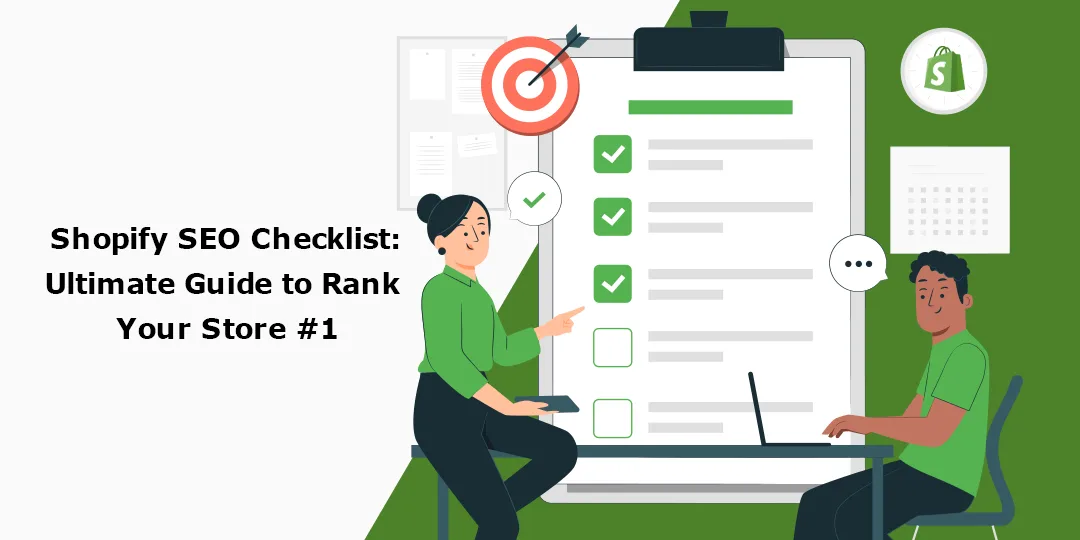In this fast-growing world, the availability of smartphones, high-speed internet, digital marketing sources, and many eCommerce platforms has easily facilitated the start of an online business.
Shopify is the most widely used eCommerce platform possessing more than 6 million online stores built on the Shopify platform. Shopify enables business owners to build a visually attractive online store that drives sales and traffic. In the intimidating competition, having only a visually stunning website is not enough; you must apply an effective SEO strategy to your Shopify business.
SEO is time-consuming, and the results can be seen after certain months or even years. But is very helpful in generating an abundance of traffic and acquiring new customers. If you want to earn brand exposure on the search engine, check out the SEO checklist for your Shopify store.
Why is SEO so Important?
Creating an SEO-friendly online store is crucial for your business to grab potential customers by ranking higher on search engine results pages. People usually don’t go beyond the first page in SERPs when searching for products. Hence, it is very important to be visible on the first page of Google search results.
If you are not visible on the first page, then you are definitely missing a huge chunk of potential customers. But you are not only the one struggling to get to the first page of Google. Many eCommerce stores are battling this because they are not aware of the importance of search engine optimization.
Shopify comes with several SEO features like sitemaps and redirection. But this is just a tiny part of SEO. You can improve the SEO of your Shopify store with best practices.
What is Shopify SEO?
SEO is the process of applying various methods and techniques for optimization so that it performs well on search engine results. Applying SEO to any website using Shopify as their CMS platform can be described as Shopify SEO.
Performing Shopify SEO helps to gain organic traffic and keyword ranking. SEO also optimizes your Shopify store’s content, which helps search engines find your content relevant to the user’s query.
Shopify SEO Checklist
This SEO checklist can be applied to any Shopify website to improve traffic and performance on Google SERPs. However, this Shopify SEO checklist is not a one-time thing. Some points need to be checked regularly with constant monitoring.
Set up the Necessary Tools
To improve the SEO of your Shopify store, you need to track and monitor users’ interaction with your website. Google Analytics and Google Search Console are useful tools that can help analyze traffic sources and user behaviour.
Google Analytics
Google Analytics is a free tool provided by Google to better understand the movement of website traffic and user behaviour once they land on your website. Google Analytics can provide you with insights on the following things:
- Conversion rate of organic traffic
- Revenue generated from SEO
- Products that are generating revenue based on organic search
Learn more about Google Analytics Insights to Improve SEO.
Google Search Console
Google Search Console is another free service offered by Google to observe, maintain, and fix the website’s visibility on Google search. Google search console can provide you with the following information:
- Queries and keywords that bring traffic
- Click-through rate in SERP
- Changes in keyword ranking
Perform Keyword Research for eCommerce
To improve the SEO of your Shopify store, you need to make sure that you use the right keywords in your website content that people are actually searching for. For that, you need to research which keywords can bring more traffic and sales. Learn How to Perform Keyword Research for eCommerce.
Keyword research involves knowing 3 aspects:
- Search intent keywords
- Search volume
- Keyword difficulty to rank
There are many tools available that can help you perform keyword research for your Shopify website. Check out Best Keyword Research Tools for SEO.
This data helps to know how much competition is there and optimize the website content. With keyword research, you can ensure that your Shopify store performs well in the search results.
Optimize Content of Shopify Store
Google cannot understand content as humans. You need to perform on-page SEO to help search engines understand what your content is about. To optimize the content of your Shopify store, consider the following points:
- Optimize the title and meta description of the important pages like the home page, products, blogs, collections, etc.
- Optimize the URLs to help customers and search engines know what the page is about.
- Include targeted keywords on the H1 and body of the text.
- You can even use synonyms and LSI (Latent Semantic Indexing) keywords instead of exact target keywords.
- Optimize the page for higher engagement by Including detailed product descriptions, highlighting reviews, using high-quality images, and relevant product links.
- Use an internal linking strategy to help Google know the content, help the user find other relevant content, and pass SEO value. Find out more to Optimize Internal Linking.
Optimize Your Images
An eCommerce store consists of hundreds and thousands of images. The search engine cannot understand images; they use alt text to find out what the image is about. Alt text helps search engines know what the image is about. Include relevant keywords to alt text to rank your images in the Google Images Search. Screen readers can better inform blind people about the images if it has alt text. Moreover, if the image cannot be loaded, alt text helps to inform the user about the image.
Before you upload an image to your site, give a meaningful name to the image. Include the focus keyword in the image file name, and make sure you keep it short. For example, “img02564.jpg” is a bad file name, while something like “red-tshirt.jpg” is an understandable name.
Strong Link Building Strategy for eCommerce
Building links is one of the powerful ways to strengthen the SEO of your Shopify store. Though link building is tough, it can be made easy with various tactics. Search engines take into account website authority to rank the website higher. The links from other sites to yours determine the site authority. Some ways to boost site authority are as follows:
- Finding links from high-authority websites is beneficial.
- Prefer having links from multiple sites instead of a single site.
- Practice guest posting on other sites with your link.
- Get product reviews from customers and add links of your products to it.
Technical SEO for eCommerce
Technical SEO issues can prevent your site from ranking and getting organic traffic. Fixing technical issues will allow search engines to easily find and crawl your website.
- Fix crawl errors that prevent your website content from being viewed correctly. Use Google Search Console to fix crawling issues.
- Switch from HTTP to HTTPS.
- Use a responsive theme that fits any screen size. Google uses the mobile version of your site to crawl and index it.
- Fix broken links negatively affecting your Shopify website by updating or removing them.
- Speed up your Shopify website as slow loading not only affects user experience but also undervalues your website for search engines.
Monitoring & Tracking
After you have implemented all the above points in this Shopify SEO checklist, there are some additional points you can look after to strengthen the SEO of the Shopify website.
- Set up rank tracking for your website. Doing so will help to know whether your efforts are working or not.
- Set up alerts for mentions of your brand and products.
- Get your brand visible on as many social media networks as possible.
Conclusion
Effective Shopify SEO can help drive your business’s organic traffic and search engine rankings. This will also result in an improved user experience of your website. Follow this SEO checklist precisely and Google will surely love you.











